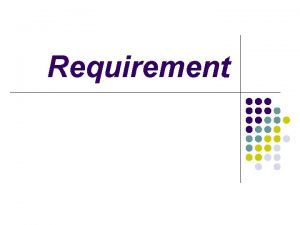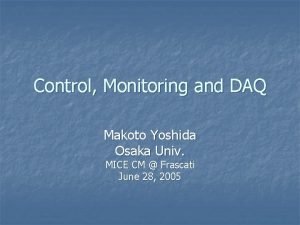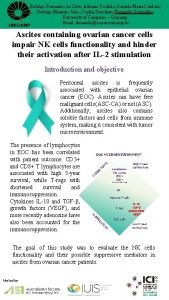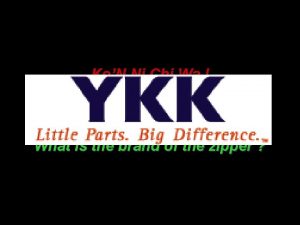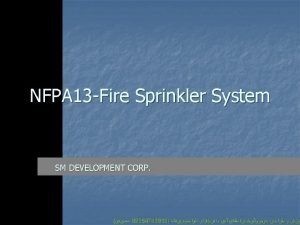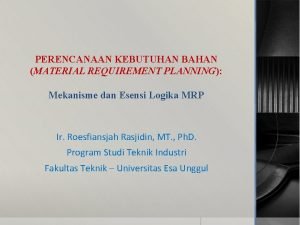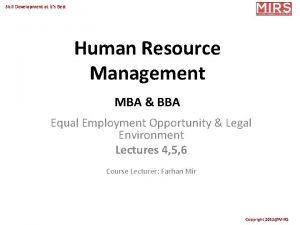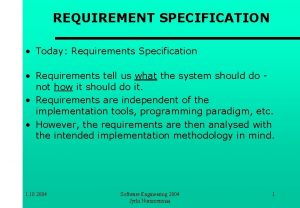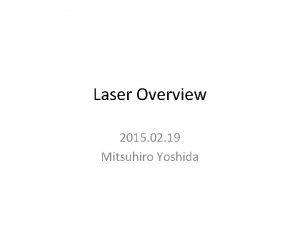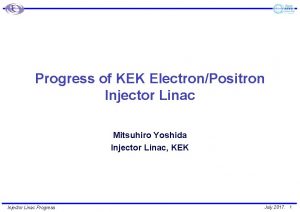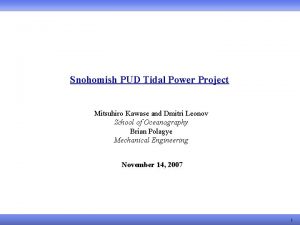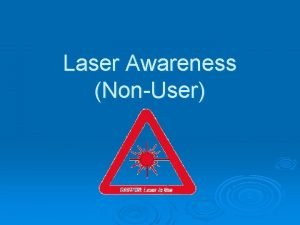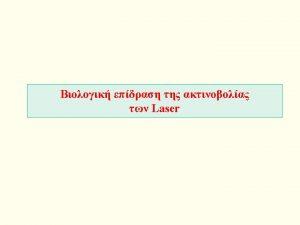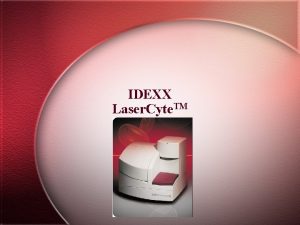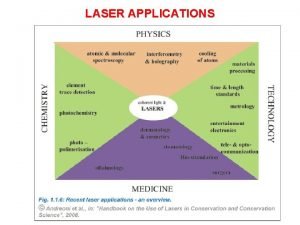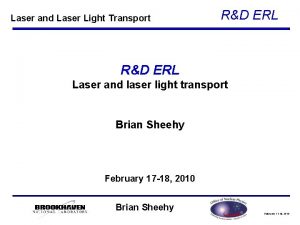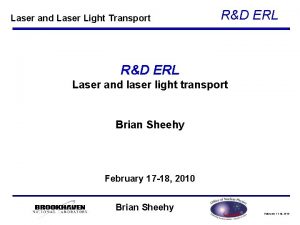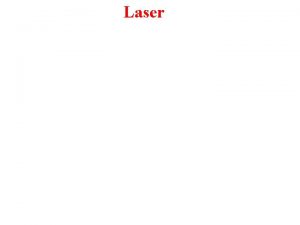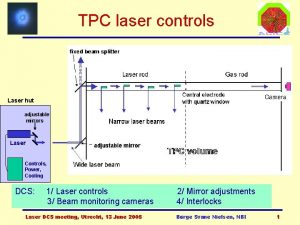Laser Overview 2015 02 19 Mitsuhiro Yoshida Requirement













- Slides: 13

Laser Overview 2015. 02. 19 Mitsuhiro Yoshida

Requirement of laser system for RF-Gun • Laser energy – 500 m. J for Ir 5 Ce cathode – 50 m. J for Ce 2 Te cathode • 50 Hz, 2 -bunch (96 ns spacing) => Difficult to adopt commertial products using regenerative amplifier. => Multi-pass amplifier or Special regenerative amplifier • Temporal pulse shaping to reduce energy spread => Broadband laser crystal (Yb or Ti: Sapphire) • Continuous operation (limited cost / human resource) – Support cost for commertial product is very high. (10 -20万円=1, 000 -2, 000$/day/person + a (margin) ) – No laser system company in Japan. – Recovering time.

Required laser pulse energy Current laser energy(500μJ) Ce 2 Te Charge( C ) QE=10 -3 QE=10 -4 Offline measurement S-polarization Offline measurement P-polarization QE=10 -5 5 n. C ATF Inclined injection Laser power ( J ) Normal injection (old 3 -2)

How to generate 2 -bunch • Amplification time of standard regenerative amplifier (usually adopted in commertial product) is around 1 ms. • Two regenerative amplifier (not good) • Large regenerative amplifier (built & failed) – Unstable output energy due to low gain. – Difficult to compensate thermal lens. • High gain fast regenerative amplifier (built & failed) – Difficult to reduce the ghost pulse from first bunch due to limted extinction ratio of pockels cell. • Multi-pass amplifier (current configuration) – More gain is required for the balanced 2 -bunch. • OPCPA (future candidate)

Energy spread reduction using temporal manipulation Energy spread of 0. 1% is required for Super. KEKB synchrotron injection. 15 n. C t 5 n. C 10 n. C 20 n. C Gaussian t Square 5 n. C electron 5 n. C 10 n. C 15 n. C 20 n. C 15 n. C Primary beam for positron production

Nd-doped Properties of laser medium Nd laser system for 3 -2 RF-Gun τ~ 200μs, 40% ○ 4 -state laser is easy to operate. SHG(532 nm) 40% LD Pump Nd: YVO 4 ○ High power pump LD is available. FHG(266 nm) 20% (808 nm) Nd: YAG ○ Large crystal is available 5 HG(213 nm) 3% × Pulse width is determined by SESAM. 808 nm 1064 nm (Gaussian) Yb-doped ○ ○ × × Wide bandwidth => pulse shaping τ~ 900μs, Long fluorescent time => High power Yb-glass Fiber laser => Stable LD Pump Small state difference Yb: YAG (941/976 nm) ASE Yb: BOYS 941/976 nm Absorption Ti-doped Pump τ=200μs, 40% Pump (808 nm) ○ ○ × × 40% SHG(520 nm) 40% FHG(260 nm) 20% 5 HG(208 nm) 3% 1040 nm Best for RF-Gun τ~ 3μs, 40% Nd: YAG SHG 808 nm 1064 nm Ti: Sapphire 532 nm 800 nm Very wide bandwidth High breakdown threshold TW laser is based on Ti-Sapphire Low cross section Short fluorescent time => Q-switched laser is required for pumping SHG(400 nm) 40% THG(266 nm) 20% FHG(200 nm) 10% Ti: Sapphire laser system for beam monitor.

Flash pumped LD pumped Absorption CPA Fluorescence Laser schemes η~ 0. 5% Nd: YAG Ti-Sapphire Oscillator Superconitnuum broadning Yb-Fiber Frontend 940 nm LD OPCPA 1030 nm Yb: BOYS, Yb: Ca. F 2 - Broadband Oscillator Pump Amplifier Nd: YAG Yb: YAG Ti: Sapphire Wavelength 1064 nm 1030 nm 660 -1100 nm Fluorescent time 230μs 960μs 3. 2μs Spectral width 0. 67 nm 9. 5 nm 440 nm 2. 48 ps 165 fs 2. 59 fs 807. 5 nm 941 nm 488 nm 1. 5 nm 21 nm 200 nm 76% 91% 55% Fourier minimum Pulse width Wavelength Spectral width Quantum efficiency Many commertial product. - How to maintain continuously? - How to generate 2 -bunch ? Yb: YAG Thin Disk η~ 40% Material - Very high gain - Critical incident angle - Fiber laser is stable in principle. - High efficiency (long fluorecense lifetime) - Low gain at room temperature => Lower temperature

Yb Fiber Laser Yb laser system (Present status) Yb Fiber Oscillator Yb Fiber Amplifier frep=52 MHz Amplitude modulator x 2 ASE problem frep=52 MHz→ 10 MHz Yb Fiber Amplifier x 2 (20 W + 70 W pump) Fiber strecher & wavelength selection Pulse picker Yb PCF Amplifier (70 W pump) frep=10 MHz→ 50 Hz λ 0→ 1030 - 1040 nm Yb: YAG laser Pulse Compression Yb: YAG Multipass Amplifier Yb: YAG 5 -pass Amplifier × 4 stage Yb: YAG Regenerative Amplifier Yb: YAG 5 -pass Amplifier 7 m. J @ 1030 nm Wavelength conversion Failed 0. 7 m. J @ 258 nm

Yb Fiber Oscillator Yb fiber oscillator: - 30 fs is possible using non-linear polarization rotation. - 52 MHz is not suitable => 114 MHz will be installed Transmission grating pair ← Remaining problem: - LD was sometimes broken. - Bunch structure at higher output power. => SESAM is not effective. => Replace some components. - 1030 nm oscillator is not stable - 1030 nm component of broadband oscillator is small => large ASE WDM Yb Fiber ← Improved items in FY 2013: - Transmission grating => Stable modelock (higher efficiency) - Super-invar breadboard => Improve thermal stability. - Piezo mirror on large lead block => Reduce vibration. - Broadband oscillator (No. 2) is stable. LD

Fiber laser system (Ideal and reality) Standalone Oscillator 52 or 114 MHz SM-fiber • 80 preamplifier Many constraints in our accelerator MHz is best oscillator frequency – But 52 or 114 MHz must be chosen. Fiber EO SM-fiber preamplifier Strecher SM-fiber preamplifier • Reduction of ASE 10 MHz – Multi stage amplification and pulse picking is required. • Pulse energy A few 100 k. Hz – No lower synchronization frequency (Only 10 MHz is available) 50 Hz => 10 m. J is expected, however much lower than this. (A few 100 n. J) • Stability – Lifetime of PCF MM-fiber preamplifier PCF pamplifier Double EO to pick up 2 -buch 50 Hz PCF pamplifier Yb: YAG solid state laser Much higher gain of Yb: YAG amplifier is required.

Main Yb: YAG Amplifier Focused type multi-pass amplifier < 1 m. J - High gain - Focused at crystal leads to avoid thermal lens effect. UV conversion (BBO SHG+FHG) => 1 m. J maximum @ 258 nm Typical charge distribution Current situation: - Instability => - No spatial shaping - No compressor Non-Focused type amplifier > 10 m. J - Low gain - Uniform pumping is required. Laser instability is caused by: - ASE of fiber amplifier. - Pointing fluctuation from fiber amplifier. - Stability of pump laser (Upgrade of charger is required) - Separated optical table between fiber and solid laser.

Cryogenic Yb: YAG • Improvement of thermal and emission property (Thermal lens effect) (Excitation density) GM+He 10 W/m/K , dn/d. T = 8 ppm/K @ 300 K 25 W/m/K , dn/d. T = 3 ppm/K @ 150 K ↑ 150 K 1/6 Thermal lens Same gain @ 1/3 excitation density → ↓ 150 K => 1/20 thermal lens 300 K P/P 0 = exp(g 0 z) ~ 2 150 K → g = 7 [cm-1] Pertier 300 K 30 k. W/cm 2

• Yb-fiber oscillator Issues on Yb based laser system – 1030 nm oscillator is not stable. – Broadband oscillator is very stable => ASE reduction is required. • Yb-fiber amplifier – Lack of pulse energy – Lifetime and stability of PCF fiber. • Yb-disk amplifier: (Regenerative amplifiers were failed) => Multi-pass amplifier for 2 -bunch operation. => More gain is required for balanced 2 -bunch energy. – 5 Hz => Soldered cryatal => 25 Hz operation => x 2 system => 50 Hz before May 2015 – Reduce thermal lens effect and simplify laser system => Focused type multipass amplifier x 2 + Non-focused multipass amplifier => Cryogenic Yb laser at next summer • Temporal shaping – Compressor and Slit • Stability improvement – – – Casing of each block. Gas filled or vacuum laser transportation to improve pointing stability. Assemble on one large optical table (new laser room). Feedback (pointing / amplitude). Increase monitor points (pointing / power / beam pattern).
 Contoh user requirement
Contoh user requirement Makoto yoshida
Makoto yoshida Marla yoshida
Marla yoshida Ruriko yoshida
Ruriko yoshida Adriana yoshida
Adriana yoshida Kon ni chi wa
Kon ni chi wa Overhead water tank plumbing diagram
Overhead water tank plumbing diagram Personnel requirement in business plan
Personnel requirement in business plan Contoh material requirement planning
Contoh material requirement planning Contoh non-functional requirement
Contoh non-functional requirement Merit badge citizenship in the community
Merit badge citizenship in the community Sdsu writing placement assessment
Sdsu writing placement assessment Bona fide occupational qualification
Bona fide occupational qualification User requirement specification
User requirement specification
